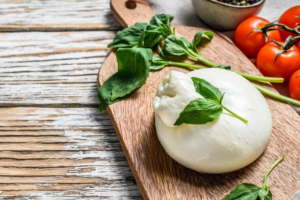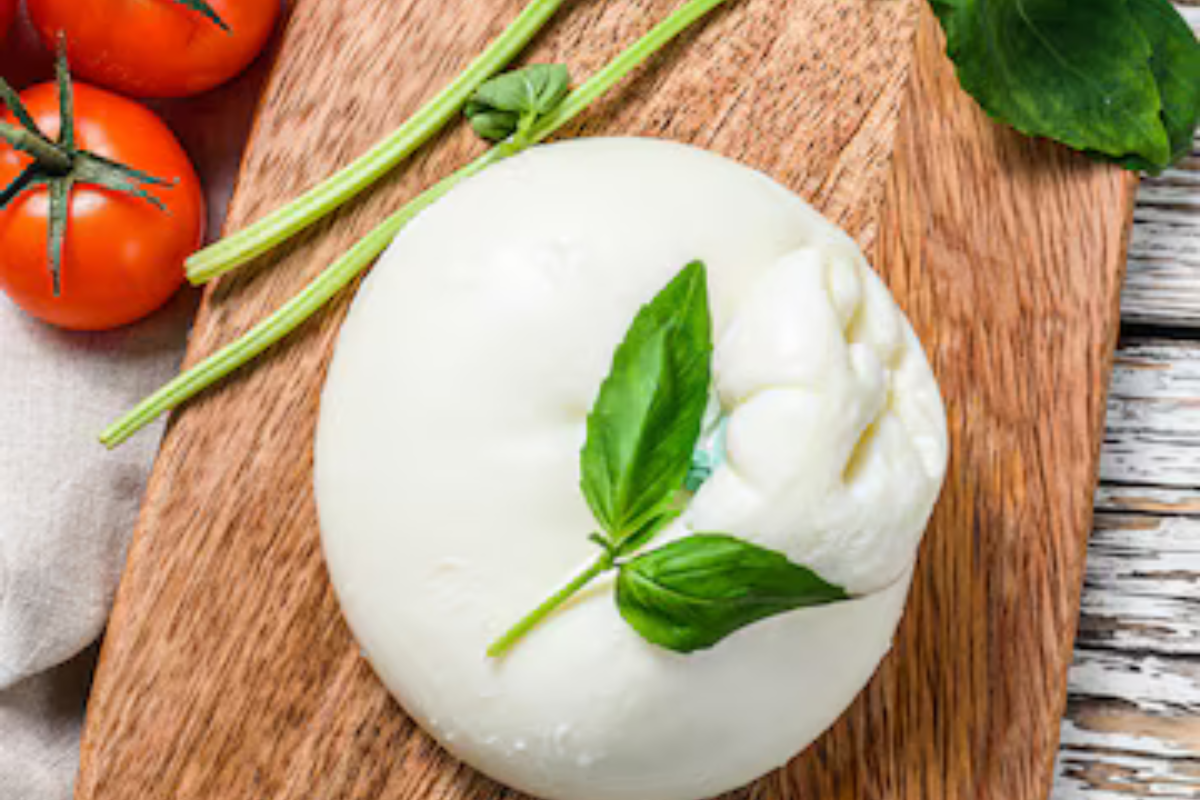Burrata cheese recipe, with its luxurious, creamy interior and soft mozzarella shell, is a true gem in the world of cheese lovers. This Italian cheese delicacy is revered for its rich flavor and indulgent texture, making it a staple in both gourmet dishes and simple home recipes alike.
But what exactly does burrata cheese recipe taste like? How is it different from mozzarella, and how can you best enjoy this cheese at home? In this detailed guide, we’ll explore everything you need to know about burrata, from its flavor profile and unique texture to its various culinary applications. Whether you’re a seasoned foodie or a curious novice, this article will provide insights into how to make the most of burrata in your kitchen.
What is Burrata Cheese recipe ?
Burrata, derived from the Italian word “burro,” meaning butter, is a fresh Italian cow’s milk cheese that originated in the Apulia region of Italy. Though it looks similar to fresh mozzarella, it offers a completely different eating experience. Burrata consists of a mozzarella outer shell, which encases a rich, creamy filling made of mozzarella curds and cream, known as stracciatella. This blend of textures firm on the outside and soft, gooey on the inside sets burrata apart from any other cheese.
Burrata was originally developed as a way to repurpose leftover mozzarella scraps. Cheesemakers would stretch mozzarella curds and then fill them with the creamy center, forming a ball to seal in all the flavors. Today, it has become a delicacy and a symbol of Italian cuisine. You can even try making your own burrata cheese at home for a fresh experience.
What Does Burrata Cheese recipe Taste Like ?
If you’ve never tasted burrata before, you’re in for a treat. Burrata has a mild, delicate flavor profile that can be described as buttery, milky, and slightly sweet. The richness of the cream adds a lush, velvety texture, which melts in your mouth almost immediately. When you slice into the cheese, the creamy interior oozes out, offering a delicious contrast to the firm outer layer.
While the taste of burrata is subtle, it pairs beautifully with a variety of flavors, from the bright acidity of tomatoes to the earthiness of roasted vegetables or grilled meats. The buttery texture and fresh cream filling make it a luxurious addition to both simple and complex dishes.
Burrata’s flavor is often compared to fresh cream or butter, making it an indulgent option for those who enjoy rich dairy products. However, despite its richness, burrata maintains a lightness that doesn’t overpower the palate. This balance of richness and subtlety is one of the reasons burrata has become so popular among chefs and food enthusiasts worldwide.
Burrata vs Mozzarella:What’s the Difference ?
At first glance, burrata may look like a ball of fresh mozzarella, but the two cheeses are distinctly different in both texture and flavor. Mozzarella is a firmer cheese, known for its stretchy, elastic consistency, which makes it perfect for melting on pizzas or in pasta dishes.
Burrata, on the other hand, offers a much creamier experience. The outer shell of burrata is indeed mozzarella, but the inside is filled with stracciatella, a mixture of cream and curds. This makes burrata much softer and richer compared to the solid consistency of mozzarella. While mozzarella is ideal for melting and cooking, burrata shines when eaten fresh, where its creamy center can be fully appreciated.
Key Differences Between Burrata and Mozzarella:
- Texture: Mozzarella is firm and stretchy, while burrata has a soft, creamy center.
- Flavor: Burrata has a richer, more indulgent flavor due to its creamy interior, while mozzarella has a milder, more neutral taste.
- Usage: Mozzarella is often used in cooked dishes, such as pizza and lasagna, whereas burrata is typically served fresh and is perfect for salads, appetizers, and garnishes.
For those who love the simplicity of mozzarella but want to elevate their cheese experience, burrata offers the perfect solution. It’s ideal for dishes where the creaminess can be showcased, such as in a fresh salad or as a topping on gourmet pizza.
The Luxurious Texture of Burrata Cheese.
One of the most defining characteristics of burrata is its luxurious texture. The combination of firm and soft elements creates an unforgettable eating experience. Here’s a breakdown of what makes burrata so unique:
- Outer Layer: Burrata’s outer shell is made from fresh mozzarella, giving it a slightly elastic, chewy texture. When you cut into it, the outer layer holds its shape, allowing the creamy center to spill out.
- Inner Layer: The inside of burrata is where the magic happens. The creamy filling, made of stracciatella (a mix of cream and cheese curds), has a soft, smooth consistency that contrasts beautifully with the firmer exterior. This combination of textures makes burrata an indulgent cheese that can be eaten on its own or used to enhance other dishes.
Burrata’s unique texture also makes it highly versatile in the kitchen. It can be served as a topping for pizza, tossed into salads, or paired with fruits for a fresh, decadent appetizer. You can even combine it with dishes like bow tie pasta salad for an unexpected twist.
How to Serve and Enjoy Burrata Cheese recipe.

Burrata’s versatility makes it suitable for a wide range of dishes, from casual appetizers to elegant main courses. Because of its delicate texture, it’s best served fresh and at room temperature to allow the creamy center to shine.
Here are some popular ways to serve burrata:
- On a Salad: One of the most common ways to enjoy burrata is in a salad. It pairs beautifully with tomatoes, fresh basil, arugula, and a drizzle of extra virgin olive oil or balsamic glaze. Try adding it to a caprese salad for an elevated version of this classic dish.
- On Toast: Burrata makes a great topping for crusty bread or toast. Spread it on a slice of warm sourdough and top with roasted cherry tomatoes or fresh figs for a satisfying snack or appetizer. If you’re into bread-based dishes, check out this guide on the best bread for French toast for more ideas.
- With Fresh Fruit: Burrata’s mild flavor complements both sweet and savory dishes. Pair it with fresh fruit like peaches, watermelon, or figs for a light and refreshing appetizer. Drizzle with honey for an added layer of sweetness.
- As a Pizza Topping: Burrata can take pizza to the next level. Add it after baking so that it maintains its creamy texture. Simply tear the burrata and place it on top of the hot pizza just before serving.
- With Grilled Vegetables: The rich creaminess of burrata contrasts well with the smoky flavor of grilled vegetables. Serve it alongside grilled zucchini, eggplant, or bell peppers for a delicious vegetarian dish.
For more inspiration, you can check out how it’s incorporated into various salads and appetizers like the buffalo chicken salad.
Best Ingredients to Pair with Burrata Cheese recipe.
Burrata’s subtle flavor makes it the perfect complement to a variety of ingredients. Its creamy consistency pairs well with sweet, savory, and even spicy flavors. Here are some of the best ingredients to pair with burrata cheese:
- Tomatoes: The acidity of tomatoes balances out the richness of burrata. Fresh, sun-ripened tomatoes work best, especially in dishes like caprese salad or bruschetta.
- Basil: Fresh basil adds a pop of herbal brightness to burrata, enhancing its creamy texture without overpowering its delicate flavor.
- Olive Oil: Drizzling high-quality olive oil over burrata brings out the cheese’s buttery notes while adding a subtle richness.
- Balsamic Glaze: The sweetness of balsamic glaze provides a nice contrast to burrata’s mild creaminess, especially when paired with tomatoes or fresh fruit.
- Cured Meats: Prosciutto, salami, and other cured meats add a salty, savory component that complements burrata’s rich, creamy texture.
- Fresh Bread: Serve burrata with crusty bread to soak up the creamy interior, creating a perfect bite with every dip.
With so many pairing options, burrata is a versatile cheese that can easily be adapted to various dishes and cuisines.
Storing Burrata Cheese recipe: How to Keep It Fresh.
Because burrata recipe is a fresh cheese, it has a shorter shelf life compared to aged cheeses like parmesan or cheddar. To ensure you get the best flavor and texture from your burrata, it’s important to store it properly.
- Refrigeration: Always store burrata in the refrigerator in its original packaging or in an airtight container. Ideally, burrata should be consumed within a day or two of purchase for maximum freshness.
- Serving at Room Temperature: Burrata should be served at room temperature to allow its creamy interior to fully develop. Remove the cheese from the refrigerator at least 30 minutes before serving.
- Freezing Burrata: Freezing burrata is not recommended, as the texture of the cheese will change significantly. The creamy center may become grainy, and the outer layer may lose its elasticity.
If you want to extend the life of your burrata, it’s best to consume it as soon as possible after purchasing. Fresh burrata tastes best when it’s eaten within a day or two of being made.
FAQs.
- Is burrata cheese lactose-free?
No, burrata cheese contains lactose since it’s made from cow’s milk and cream. People with lactose intolerance should consume burrata in moderation or look for lactose-free alternatives. - Can you eat the outer shell of burrata?
Yes, the outer shell of burrata is made of mozzarella and is completely edible. In fact, the combination of the firm outer shell and creamy center is what makes burrata so unique. - Why is burrata more expensive than mozzarella?
Burrata is more labor-intensive to make and has a shorter shelf life, which increases its price compared to mozzarella. The addition of cream and the careful crafting of the outer and inner layers also contribute to its premium cost. - How do you pronounce burrata?
Burrata is pronounced as “boo-rah-tah.”
Conclusion.
Burrata cheese adds a buttery flavor and rich texture to elevate any dish. Whether in salads, with fruit, or as a pizza topping, its indulgence is unmatched. Its mild, creamy flavor and versatile nature make it a must-try for anyone looking to expand their cheese repertoire.
For those who love creamy cheeses like cream cheese or mozzarella, burrata offers an even richer, more complex experience that is sure to impress at your next meal.
Now that you know what burrata cheese tastes like and how to use it, why not try incorporating it into your cooking? From gourmet appetizers to simple snacks, burrata is a versatile and delicious addition to any kitchen.

